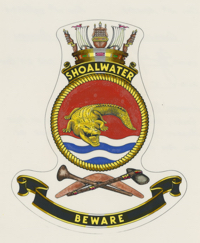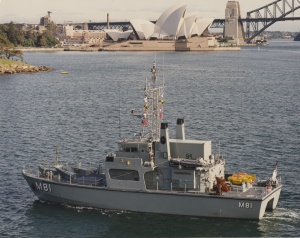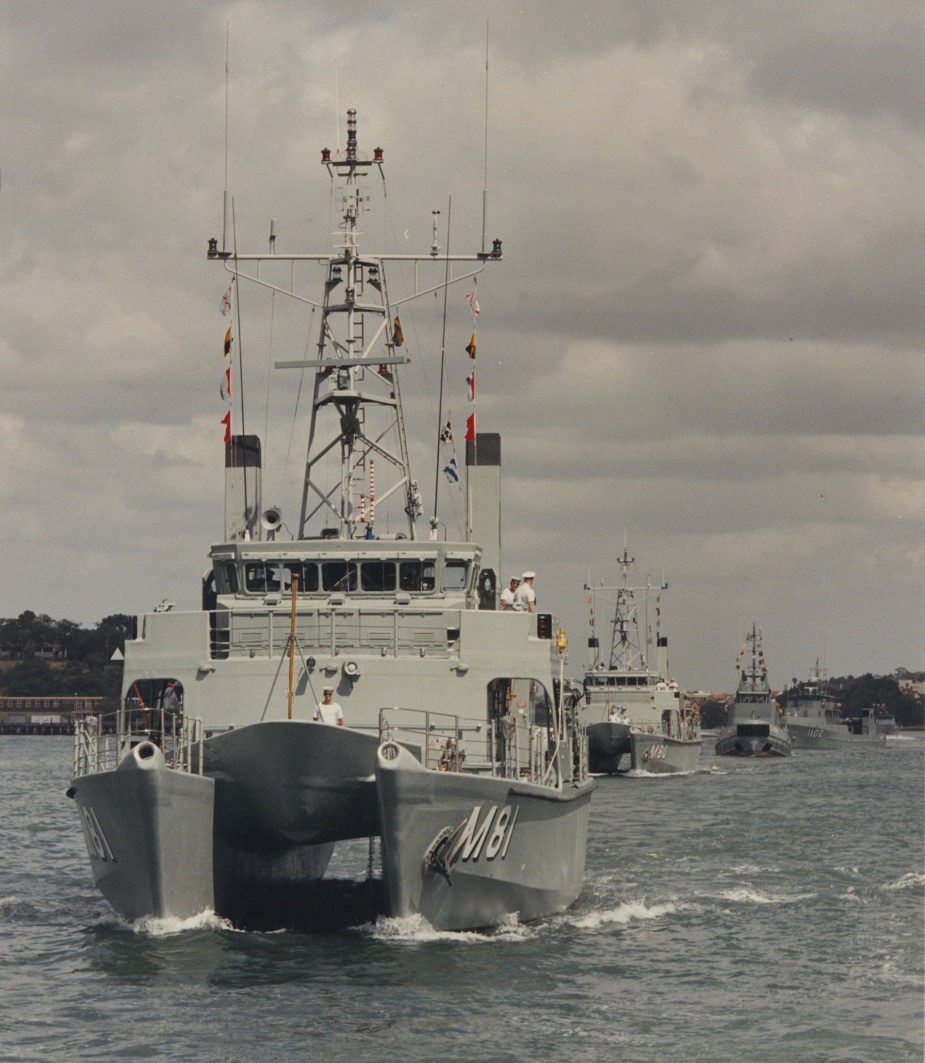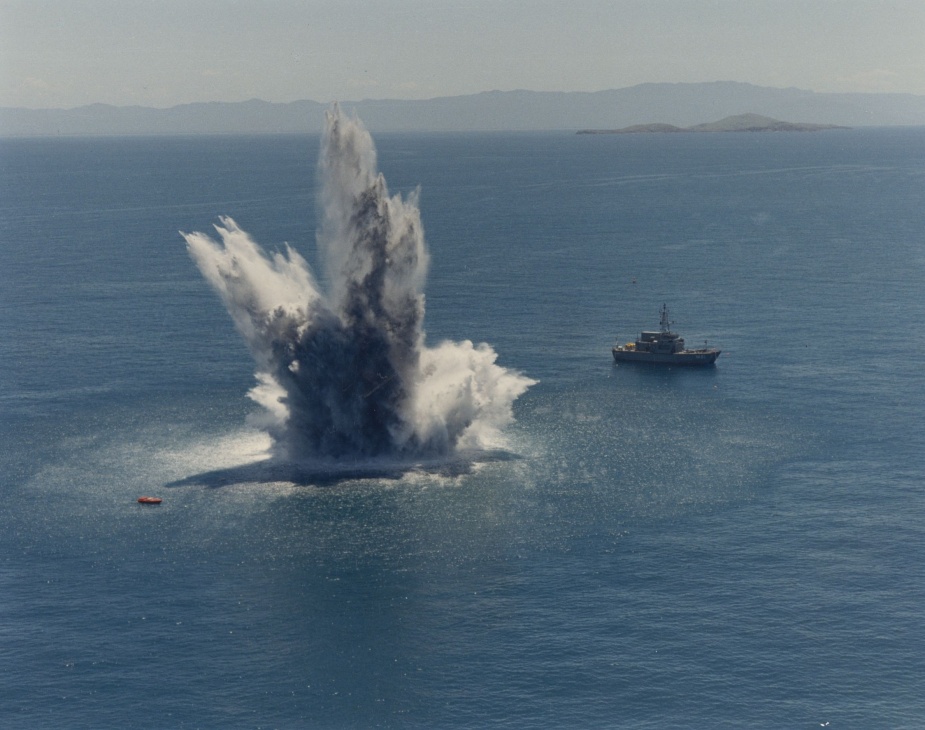HMAS Shoalwater
| Class |
Bay |
|---|---|
| Type |
Minehunter Inshore |
| Pennant |
M81 |
| Builder |
Carrington Slipways, Newcastle, NSW |
| Laid Down |
17 September 1985 |
| Launched |
20 June 1987 |
| Launched by |
Mrs Carla Hudson, wife of Australia’s Chief of Naval Staff |
| Commissioned |
10 November 1987 |
| Decommissioned |
14 August 2001 |
| Dimensions & Displacement | |
| Displacement | 170 tonnes |
| Length | 31 metres |
| Beam | 9 metres |
| Draught | 2 metres |
| Performance | |
| Speed | 10 knots |
| Complement | |
| Crew | 2 officers and 11 sailors |
| Propulsion | |
| Machinery | 2 x Poyaud Diesel Engines driving 2 x independent Schottel propulsion steering units |
| Armament | |
| Guns | 2 x .50 calibre machine guns |
| Electronic Warfare | 2 x PAP 104 remote controlled mine disposal vehicles |

HMAS Shoalwater was ordered in January 1983 as part of an initial two ship build using a ‘first’ in prototype glass reinforced plastic catamaran construction. The genesis of the design was to have a vessel able to conduct mine hunting operations locating and destroying seabed mines in depths up to 90 metres. It was to be cheaper than a conventional mine countermeasures vessel and able to be quickly produced in Australia. The Mine Hunter Inshore (MHI) was to complement the intended larger replacement to the Ton Class minehunter, of which HMAS Curlew was the last in commission. In view of the Bay Class nomenclature, the ship’s name was chosen after Shoalwater Bay in Queensland.
The ship was designed by the Royal Australian Navy in conjunction with the Department of Defence. The design was deemed a revolutionary step away from traditional designs for mine countermeasure platforms, with a number of improved features present. These included the ‘catamaran style’ hull that was to provide stability and a larger deck area for its size, greater manoeuvrability than a mono hull, and the ability to install heavier and bigger loads high up. Thereby reducing magnetic and acoustic signatures. The foam sandwich construction style was considered easy to build and maintain and it minimised the magnetic influence and noise transmission. It also provided good thermal insulation properties.
Built by Carrington Slipways at its Ramsay Fibreglass Facility at Tomago, New South Wales, Shoalwater was laid down in September 1985 and launched 21 months later. With her sister ship HMAS Rushcutter, the tender cost was $26.6m.
In her role as an inshore minehunter, the containerised weapons system formed the core of the MHI capability. The tender cost for two mine hunting weapons systems was $12m, main elements of which were an advanced high definition sonar for mine hunting, precise navigation equipment, and a tactical data system to integrate and process the information required for detecting and classifying mines. The final component was a remote controlled vehicle to deliver a weapon charge with which to dispose of the located mine. The MHI propulsion system also allowed the platform to hover in situ.
HMAS Shoalwater was commissioned alongside her home-base HMAS Waterhen in Sydney, on Saturday 10 October 1987 under the command of Lieutenant John Griffith RAN. Whilst her sister ship Rushcutter had been commissioned at the Tomago facility, Shoalwater had been brought to Sydney at the end of September after completing a Post Delivery Availability (PDA) and initial builder’s harbour and sea trials following her previous June launch.
November 1987 saw Shoalwater deploy to Townsville for shock trials in company with GPV Banks. En route to Townsville, the MHI required an emergency port main engine change out at Coffs Harbour. The latter series of six monitored shock trials were completed by mid-December, however one shot caused extensive damage to fitted mechanical and electrical items, which blacked the MHI and required three days alongside to effect repairs. Shoalwater in company with Banks departed Townsville on 15 December, arriving in Sydney six days later.
RAN Trials and Assessment Unit (RANTAU) sonar trials which began on 20 January 1988 were short lived, with Shoalwater back alongside the following day due to engineering issues. Whilst scheduled to participate in the Australia Day Bicentennial Fleet Entry into Sydney Harbour, machinery limitations now prevented this and further repairs and modifications to Shoalwater’s main engines resulted in her remaining unserviceable until August. At the end of July the MHI moved to Pyrmont to participate in the 21st International Boat Show. Machinery problems rectified, Shoalwater resumed acoustic trials in August within Sydney Harbour with a port visit to Coffs Harbour being conducted in September. After participation in the Bicentennial Naval Salute on 1 October, the MHI prepared for its second Post Delivery Activity at the Tomago Carrington Slipways facility in Newcastle. Early December saw the ship enter refit during which bilge keels were fitted as a major design and sea keeping modification. Back in Sydney on 7 December, the trials program resumed for the next nine days before the Christmas/New Year leave period.
The beginning of 1989 saw Shoalwater undertaking an Assisted Maintenance Period (AMP) followed by a short visit to Newcastle in support of Australia Day and the annual Regatta. The trials program continued in February and March in and around Sydney Harbour and the East Australia Exercise Area (EAXA). At the beginning of April Shoalwater conducted a four day port visit to Brisbane before resuming degaussing trials in Sydney followed by a four week AMP. In September with the majority of the MCM fleet and forces, Shoalwater participated in its first exercise, MCMX 1/89, conducted in the Port Kembla environs.
For Australia Day 1990 Shoalwater returned to Newcastle for a five day port visit in company with HMA Ships Curlew and Betano. In late February, Shoalwater entered a five week Repair and Overhaul period at the Tomago facility. The timeframe for the maintenance quickly extended as a result of union activity within the Carrington Slipways as the company retrenched the majority of its fibreglass division workforce. Following the time spent at Tomago, Shoalwater proceeded to Jervis Bay to conduct first of class helicopter transfer trials which ended in late June. In July Shoalwater underwent the first three week work up program and Operational Readiness Evaluation (ORE) for the Bay Class, on completion of which a weekend port visit to Newcastle was made. During the next few months, Shoalwater remained in the Sydney surrounds either in AMP, completing training or acting as consort for Rushcutter’s work up and ORE. In mid-September the MHI participated in the three week MCMX 1/90 in the Townsville environs having transited via Brisbane and Gladstone. On completion of the exercise in early October, sonar methodology trials were conducted before the return passage to Sydney via two to three day port visits to Mackay, Brisbane and Port Macquarie. Following AMP and further self-noise trails, November saw Shoalwater deploy to HMAS Cerberus at Westernport, Victoria for training and in support of a VIP sea day. During the return passage to Sydney in early December an unexpected two day port call to Port Welshpool was made to rectify an engineering defect.
Australia Day celebrations for 1991 were once again spent in Newcastle, where Shoalwater acted as Flagship for the Newcastle Maritime Museum Regatta. For the first two weeks of February the MHI was in Jervis Bay participating in MCM Squadron Exercise (SQUADEX) MULGOGGER 1/91 after which an ongoing survey of the Shallow Minefield was progressed. At the end of the month Shoalwater commenced noise modifications at the ADI (Australian Defence Industries) Refit Facility Ryde until mid-May when she returned to Waterhen to finalise the modification tasks and set the ship to work. Following a port visit to Coffs Harbour in mid-July, the MHI was back out of the water at the ADI Ryde facility for replacement sonar modifications. Following a period alongside Waterhen for September, Shoalwater commenced the month-long contractor trials for the new Thomson sonar. In Jervis Bay at the beginning of November, the MHI was despatched at short notice to Bass Strait to assist in the search for wreckage from the crashed RAAF B707 transport/refuelling aircraft, but was recalled mid transit. Shoalwater later provided lead through training support for the Major Fleet Units participating in the Fleet Concentration Period (FCP) 2/91, completed the sonar acceptance trials and provided a training platform for the Mine Warfare School before returning to Sydney in the first week of December.
Sonar accuracy trials in mid-January commenced Shoalwater’s year for 1992. In support of Australia Day celebrations, the MHI participated in the ‘Fly the Flag Afloat’ procession conducted in the Darling Harbour and Cockatoo Island area. Further sonar trials and an AMP were conducted in February with Shoalwater later proceeding unaccompanied to Devonport, Tasmania for a port visit between 24 and 30 March. The visit was conducted as part of the handover by a local company of the Partial Forward Support Unit developed for the mobile MCM operations. Back in Jervis Bay, sonar trials were resumed as well as participating with the Major Fleet Units involved in FCP 2/92. Following a short AMP at Waterhen, mid-June saw Shoalwater proceed north to Cairns for a warm water Mine Hunting Weapon System (MHWS) trials program conducted during July and the first half of August. Port visits to Brisbane and Mackay en route to Cairns were also made. Following the trials, Shoalwater in company with Rushcutter, returned to Sydney, arriving on 4 September. Later in the month the MHI returned to the ADI Ryde facility for refit and further mine hunting system modifications.
Back in the water in mid-February 1993, Shoalwater’s refit continued alongside at Waterhen for another month. Following post refit sea trials, shake down and a sea check, the MHI spent most of April in Jervis Bay undergoing sonar and noise trials. A five day port visit to Ulladulla for the ‘Blessing of the Fleet’ - a long standing local festival, was also conducted. May to mid-July involved AMP, a leave period, an unscheduled engine change out and time in Jervis Bay integrating the Atlas Electronik MWS80-5 Minehunting System. Early August saw Shoalwater transit to Darwin for Exercise NEW HORIZON 11/93 visiting Mackay, Cairns and Thursday Island en route. The return voyage saw the MHI visit Gove, Cairns and Mackay. Continuation of system trials, mine warfare training and consort support continued in Jervis Bay in September and October interspersed with AMP and leave periods in Sydney. Back in Townsville in November, Shoalwater participated in Exercise DUGONG 93-2 and for the first time conducted a live Mine Disposal Charge firing.
Shoalwater’s 1994 program did not commence in earnest until February when the MHI completed an Operational Training Period (OTP) and tasks in Jervis Bay. Route Survey Operations were conducted in and around Port Phillip Bay, Victoria for several weeks in early March, with the ship visiting Geelong and Adelaide during the task. Further training tasks in Jervis Bay, another visit to Ulladulla for the annual ‘Blessing of the Fleet’ festival, and a Self-Maintenance Period (SMP) rounded out the end of April. While transiting in heavy seas to Newcastle for the May Exercise HUNTER 94, Shoalwater responded to a distress call by the yacht ‘Rock and Roll’, taking it safely in tow to shore. Participation in the ensuing exercise was curtailed due to an engineering defect, forcing the return to Sydney for repairs, leave and an AMP. On Friday 24 June, Shoalwater and her sister ship Rushcutter were officially accepted into Naval Service. Following an early June work up and ORE, the MHI operated in Jervis Bay for the next period, briefly visiting Newcastle for the Minehunter Coastal contract signing on Friday 12 August. An AMP and engine repairs dominated October before sailing in early November for the MCM FCP 2/94 in Jervis Bay.
Ongoing hydraulic engineering issues required Shoalwater to remain alongside Sydney from January to April 1995 effecting replacement repairs. After a successful sea check, the MHI participated in Exercise PHOSPHORBRONZE 95 in Jervis Bay in May. July saw Shoalwater deploy to northern waters for Exercise KANGAROO 95 in the Torres Strait area conducting port visits to Brisbane, Townsville and Cairns en route. On completion of the exercise, in company with Rushcutter, Shoalwater participated in VLF sonar trials in the Townsville area before operating in the vessels’ namesake Shoalwater Bay. For the return voyage to Sydney, an early September port visit to Bundaberg was made. Once home, VLF sonar trials continued in Jervis Bay before the MHI participated in Exercise SHORTSCOPE/DUGONG 95/1 in the Newcastle area at the end of November.
Following shake down in mid-January 1996, Shoalwater participated in the MCM SQUADEX Exercise MULGOGGER 96 in the EAXA. In early March a five day port visit to Devonport Tasmania occurred before an SMP back in Sydney and thence MW training in Jervis Bay in company with Rushcutter. After the now traditional visit to Ulladulla for the ‘Blessing of the Fleet’ festival in early April, Shoalwater deployed to Townsville in May for Exercise HUNTER 96. Training and trials in the Jervis Bay continued for the majority of July. In August Shoalwater conducted what was thought to be the first RAN lead-through of a submarine into Sydney Harbour (HMAS Onslow). The MHI then entered refit at ADI Garden Island Dockyard for the next two months. Shakedown and work up occurred in mid-November before the Christmas/New Year leave period.
Following the Australia Day long weekend, Shoalwater’s 1997 program commenced in earnest with shakedown and demonstration trials within Rose Bay. Various unrelated engineering issues soon afflicted the MHI, requiring her to withdraw from February’s MULGOGGER 97 MCM SQUADEX and other EAXA activities. In mid-April Shoalwater was back at sea, transiting to Cairns via Gladstone for Defence Science and Technology Organisation (DSTO) MOD Trial 5/97 sonar trials. In early May the MHI returned to Sydney via a port visit to Bundaberg before two weeks’ of MCM continuation training in Jervis Bay. The remainder of the year was spent conducting routine training and maintenance, with November seeing Shoalwater transit to Moreton Bay and Brisbane River environs for Exercise SHORTSCOPE 97 returning to Sydney at the beginning of December.
As with most years, Shoalwater’s first significant activity for 1998 was the MCM SQUADEX Exercise MULGOGGER 98 in early February with inclusion in FCP 98-1 serials. Sea time in March was limited, but increased again in April, with the MHI participating in Exercise HUNTER 98 in the Newcastle area and a port visit to Coffs Harbour after Anzac Day. May was spent alongside at Waterhen in AMP, then an extended leave period until mid-July. An AMP and further sonar trials occurred in September and for the remainder of the year the MHI conducted various MCM activities, culminating in a very successful participation in Exercise SHORTSCOPE/ DUGONG 98 within Jervis Bay.
February 1999 saw Shoalwater participate in Exercise MULLGOGGER before FCP1/99 in Jervis Bay. March was spent alongside in AMP before resuming various Mine Warfare Faculty (MWF) tasks in Jervis Bay in mid-April. In August, trialling 24 hour operations through double crewing occurred in Jervis Bay, whereby Shoalwater’s crew alternated with Rushcutter’s crew completing 12 hour operating cycles in the one MHI platform. Exercise CROCODILE 99 in the Gladstone environs was the highlight for September. Following a short AMP, Shoalwater was back at sea for November, with the MHI participating in Exercise SHORTSCOPE/DUGONG 99 within Jervis Bay before commencing the Christmas/New Year leave period in mid-December.
Alongside for the commencement of the new millennium, Shoalwater resumed the normal pattern of February activities with MULGOGGER followed by FCP 1/00. Inclement weather prevented the MHI visiting Bermagui for their Seaside Fair in early March and following an AMP in Sydney Shoalwater undertook Mine Warfare training support in early April. Participation in Exercise HUNTER 00 occurred in Broken Bay in mid-May with DSTO trials support at the end of the month. In mid-June, in company with Rushcutter, the MHI conducted a port visit to Melbourne and Geelong with an overnight visit to Eden enjoyed during the return trip. DSTO trials support in Broken Bay in mid-July was Shoalwater’s sole activity for the month, before undertaking her final operational commitment in Jervis Bay in early August. A families’ night was conducted on Friday 11 August before the MHI officially ceased running the following day and reverted to 60 days’ notice for sea. Laid up for the next year, the ship formally decommissioned on Friday 14 August 2001.
Sold by tender in 2002, Shoalwater and Rushcutter saw service in the Persian Gulf before further disposal.
Commanding Officers
| 10 October 1987 - 8 October 1988 | LEUT J.R Griffith, RAN |
| 8 October 1988 - 23 April 1990 | LEUT P.C Fryer-Hornsby, RAN |
| 23 April 1990 - 9 October 1992 | LEUT J.B Carter, RAN |
| 9 October 1992 - 29 April 1994 | LCDR B.C Smyth, RAN |
| 29 April 1994 - 12 October 1995 | LCDR P.R Day, RAN |
| 12 October 1995 - 24 April 1997 | LCDR B.W Jones, RAN |
| 24 April 1997 - 14 May 1999 | LCDR D.A Waldie, RAN |
| 14 May 1999 - 14 August 2001 | LCDR M.L Maley, RAN |





